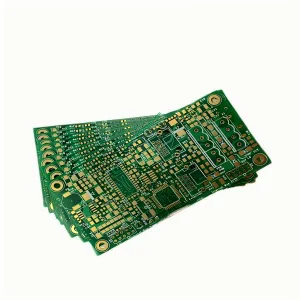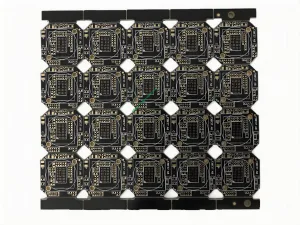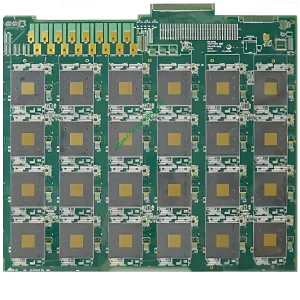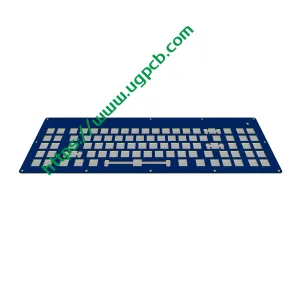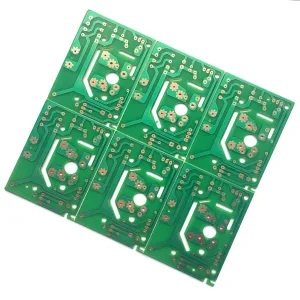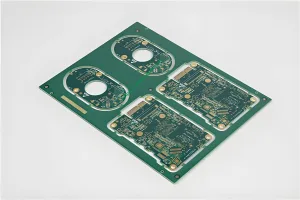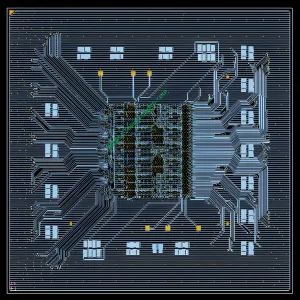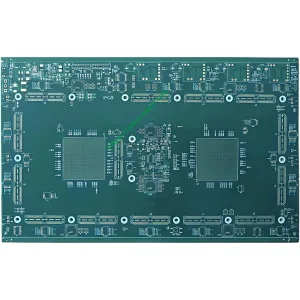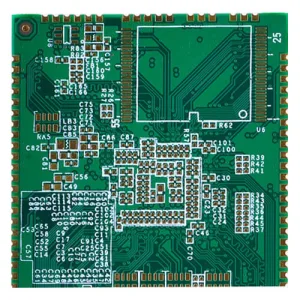2 상단 및 하단을 포함하여 양쪽에 구리 코팅 된 층 PCB. 가장 일반적이고 일반적인 PCB 회로 보드입니다.. 절연 기판의 양쪽에는 전도성 그래픽이 있습니다, 양쪽의 전기 연결은 주로 VIA 또는 패드를 통해 연결됩니다.. 양쪽을 연결할 수 있기 때문입니다, 배선의 어려움이 크게 줄어 듭니다, 널리 사용됩니다.
양쪽에 배선이 있습니다 2 레이어 PCB, 하지만 양쪽에 전선을 사용하려면, 두 레이어 사이에 적절한 회로 연결이 있어야합니다.. 이것 “다리” 회로 사이를 파일럿 구멍이라고합니다. 가이드 구멍은 PCB 보드의 금속으로 채워 지거나 코팅 된 작은 구멍입니다., 양쪽의 와이어와 연결할 수 있습니다.. 양면 보드의 면적이 단일 패널의 영역보다 두 배나 커서, 양면 보드는 단일 패널에서 비틀 거리는 배선의 어려움을 해결합니다. (구멍을 통해 다른쪽에 연결할 수 있습니다.), 그리고 단일 패널보다 더 복잡한 회로에 더 적합합니다..
차이 2 레이어 PCB 대 4 SMT 처리의 층 PCB
2 레이어 PCB
비교 4 레이어 PCB 보드, 단순한 디자인으로 인해 양면 PCB 보드가 사용하기가 더 쉽습니다.. 단일 패널만큼 간단하지는 않지만, 양면 입력 함수를 희생하지 않고 가능한 한 간단합니다.. 복잡성 감소는 동일한 가격표로 이어집니다., 그러나 이것은 4 층 PCB 보드보다 가능성이 낮다는 것을 의미합니다.. 하지만, 업계에서 가장 일반적으로 사용되는 서킷 보드로, 그것의 중요한 이점은 신호 전파 지연이 없다는 것입니다..
4 레이어 PCB
4 층 보드 PCB는 양면 PCB 보드보다 표면적이 더 큽니다., 더 많은 배선의 가능성이 증가합니다. 그러므로, 그들은 더 복잡한 장비에 매우 적합합니다. 그들의 복잡성 때문에, 생산 비용이 높아지고 개발이 느려질 것입니다.. 또한 전파 지연 또는 상호 영향을 줄 가능성이 높습니다., 따라서 합리적인 디자인은 매우 중요합니다.
2 레이어 PCB 설계 규칙 – 비아 및 패드
VIA는 통로라고 불립니다, 구멍으로 나눌 수 있습니다, 블라인드 홀, 그리고 매장 된 구멍. 주로 네트워크의 다른 계층에서 와이어 연결에 사용됩니다.. 플러그인 홀 용접 요소로 사용할 수 없습니다.. 구멍 직경을 통해 생산 중에는 제어되지 않습니다.
패드는 핀 패드 및 표면 결합 패드로 나눌 수 있습니다.. 핀 패드에는 용접 구멍이 있습니다, 이는 주로 용접 핀 구성 요소에 사용됩니다. 표면 결합 패드는 용접 구멍이 없으며 주로 용접 표면 결합 성분에 사용됩니다..
패드 홀의 직경은 생산 중에 제어해야합니다., 플러스 또는 마이너스 0.08mm의 공차.
주로 전기 연결의 역할을 수행합니다. 실제 생산에서, 구멍을 늘리고 구멍 나이프 생산을 늘릴 수 있습니다., 나이프 수를 줄이고 작업 효율성을 향상시킵니다, 또는 제한된 라인 간격 및 선폭 공간으로 인한 조리개를 생산 요구 사항을 충족시키기 위해 조리개를 줄입니다..
VIA의 조리개는 일반적으로 작습니다, 플레이트 제작 과정을 달성 할 수있는 한 일반적으로 충분합니다.. 표면을 통해 솔더 저항 잉크로 코팅 될 수 있습니다.; 패드는 전기 연결의 역할을 수행 할뿐만 아니라 기계 고정의 역할을 수행합니다.. 패드의 조리개는 구성 요소의 핀을 통과 할 수있을 정도로 커야합니다., 그렇지 않으면, 그것은 생산 문제로 이어질 것입니다; 게다가, 패드 표면에는 솔더 저항 잉크가 있어야합니다, 용접에 영향을 미치기 때문입니다. 홀 공차는 플러스 또는 마이너스 0.08mm 또는 크거나 작은 것으로 제어해야합니다.. 이로 인해 설치가 느슨합니다.
2 레이어 PCB 제조 공정
양면 PCB 구리 클래드 시트 절단, 하나의 드릴 참조 구멍, 하나의 수치 제어 드릴 홀 1 개의 테스트, 하나의 디버링 1 개의 브러시 전기 도금 (통로의 금속 화) 하나의 풀 플레이트 전기 플레이팅 얇은 구리 1 개의 테스트 브러핑 한 화면 인쇄 네거티브 회로 그래픽, 응고 (건조하거나 젖은 필름, 노출, 개발) 하나의 테스트, 트리밍 보드의 일차 패턴 하나의 전기 도금 틴을 전기 도금합니다 (반응성 니켈/금), 하나의 인쇄 재료 (사진 영화), 하나의 에칭 구리와 하나의 주석 제거 1 개 청소 1 스크린 인쇄 솔더 그래픽. (건조하거나 젖은 필름, 노출, 개발, 열 경화, 일반적으로 사용되는 광분 경화 녹색 오일) – 청소, 하나의 화면 인쇄 마커 문자 그래픽 건조, 하나의 모양 처리를 치료합니다, 청소, 등. 건조 및 전기 브레이크 테스트에서 주석 스프레이 또는 유기 결합 필름 테스트 패키지 완성 된 제품 공장.
전기 도금 구리 층의 품질 관리 2 레이어 통과 구멍 인쇄 회로 보드는 매우 중요합니다, 다층 또는 다층 보드가 고밀도로 개발되기 때문에, 높은 정밀도, 다기능은 점점 더 엄격한 결합력을 필요로한다, 균일 한 최종, 인장 강도, 및 구리 도금 층의 신장, 그래서 통로 인쇄 회로 보드에서 전기 도금의 품질 관리가 특히 중요합니다..
균일 성과 일관성을 보장합니다 2 층 PCB 구리 도금 층, 높은 종횡비 인쇄 회로 보드에 대한 대부분의 구리 도금 공정은 고품질 첨가제에 의해 도움이됩니다., 적당한 공기 교반 및 음극 이동과 결합, 상대적으로 낮은 전류 밀도 조건에서, 구멍에서의 전극 반응의 제어 영역이 확대되도록, 전기 도금 첨가제의 역할을 표시 할 수 있습니다. 게다가, 음극 운동은 도금 용액의 깊은 도금 능력을 향상시키는 데 매우 도움이됩니다., 도금 된 부분의 편광을 증가시킵니다, 도금 층의 전기 결정화 과정 동안 결정 핵의 형성 속도 및 결정의 성장 속도를 보상합니다., 따라서 고축성 구리 층을 얻는다.
물론, 전류 밀도는 실제 도금 영역에 따라 설정됩니다. 2 레이어 PCB. 전기 도금 원리로부터, 전류 밀도의 가치는 또한 주 소금 농도에 따라야합니다., 솔루션 온도, 첨가제 내용, 및 높은 산 및 저 구리 전해질의 교반 정도. 한마디로, 구리 도금의 기술 파라미터 및 조건은 구멍의 구리 도금 층의 두께가 기술 표준을 준수하도록하기 위해 엄격하게 제어되어야합니다..
UGPCB Company는 전문 PCB 회로 보드 제조업체입니다. 우리는 낮은 2 층 PCB를 대량 생산할 수 있습니다 2 레이어 PCB 비용, 그래서 우리는 저렴하게 제공합니다 2 레이어 PCB.
 UGPCB 로고
UGPCB 로고


